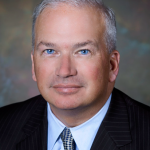2007-03 Vital Source Mag – March 2007
The Underpants
By Peggy Sue Dunigan In 1910, when this play was written, “a glimpse of stocking was shocking” and ultimately humorous. On a weekend in 2007, the shock factor may be slightly removed but the comedy continues as RSVP Productions presents a 90-minute version of The Underpants. Originally penned under the title Die Hose by Carl Sternheim, actor and comedian Steve Martin adapted the play, relieving the script of its more biting moments that had led the German government to originally ban the production. Martin infuses the original two acts with his own brand of sophisticated comedic timing and sexual innuendo while still retaining the commentary on class, feminism and fleeting fame. The company’s decision to reduce the play to one act does leave some of the impact, in both comic and social interpretation, behind. But RSVP’s performance, especially the female characters, still connects with the audience. Kelly Simon as Louise is perfect as the pretty “housfrau” who causes a stir by exposing her stockings during a parade in the park. Suddenly Louise is famous for her faux pas, which understand upsets her working class husband, Theo (Ken T. Williams). A striking, if not frightening, similarity to the tabloids today that speak to Britney Spears, sans underwear. Two men who “glimpsed this shocking event” seek to rent a room in the couple’s apartment, wishing to woo Louise as their lover. Louise’s friend and upstairs neighbor, Gertrude (Missy DeIrueste), encourages Louise in her newfound position of power and fashions even more exquisite underwear for her so she is able to optimize her options. DeIrueste’s role as Gertrude is reduced in this version, which is slightly dismaying as the two women, both in character and chemistry, create a strong presence when on stage. And the stage, for a small theatre company, sets the apartment of the German newlyweds quite appropriately giving added dimension to the production. Considering the American appetite and appreciation for lingerie, several elements in this script’s premise remain completely believable on a stage today, although subtly eccentric. Martin’s adaptation, along with the RSVP production, always extends the humor, laughs and smiles with each line. Yet the play consistently reflects, perhaps even in a more timely fashion, on the nature of fame – creating celebrities for the moment concurrent with the public’s fascination for the minuteness of events. VS The Underpants is presented by RSVP Productions in the Astor Theatre at the Brady Street Pharmacy, 1696 North Astor Street, through March 3: 414.278.0765 or www.rsvptheater.com
Mar 1st, 2007 by Peggy Sue DuniganCé
By Evan Solochek + Photo By Richard Galling With Milwaukee’s strong Irish heritage, it’s no wonder that traditional Irish music is a fixture in this city. For proof, just check out Irish Fest, the Badger State Feis, the Cream City Feis, the renowned Celtic Irish Studies Program at UWM and the numerous pub sessions that occur on a weekly basis throughout the city. And prominent at each one of these Irish institutions is Milwaukee’s very own Cé. This local trio, made up of Asher Gray (flute, whistle, bouzouki, bodhrán), Randy Gosa (guitar, tenor banjo) and Devin McCabe (fiddle, concertina, whistle), play traditional and contemporary music from Ireland, England and Brittany. And while young, these three multi-instrumentalists have more than 35 years of musical experience between them and bring to this old-world craft a unique modern perspective, not to mention a level of skill often only seen in musicians twice their age. To hear more from Cé, check out myspace.com/cemusic or cemusic.net. 1. How did you three meet? I (Asher) met Devin when I was 14 or 15 and we’ve been playing together in sessions and different bands like Anam Rí and now Cé. Around the time that Anam Rí was coming to an end we started playing tunes with Randy in sessions around Milwaukee. It just seemed right that the three of us start a new group because we all shared a common passion for the music. 2. How would you describe Traditional Irish music to someone who had never heard it before? Traditional Irish music is dance music. It is directly connected to the roots in the dancing that accompanies it. Tunes provide a framework for dancing and for musicians to improvise over. 3. How does your young age affect your reception from either the audience or fellow Irish musicians? People who aren’t familiar with the music are sometimes surprised to see three guys in their 20s playing traditional music. I think it gives a little edge and helps to keep the audience’s attention. Anyone that plays it, though, knows that it’s music for all ages. I wouldn’t be surprised to see an 8 year old playing with an 80 year old. 4. Who would Cé like to collaborate with and why? We have always wanted to work with singers. As an instrumental band, our music yearns for that final element of vocal expression. Recently, Randy has been working with a singer from Boscobel named Andreas Transo, who would be a lovely addition. 5. What are your goals for Cé? We’re focusing on getting more gigs around the country and in Europe. There are so many great festivals and venues all over the world that focus on world and Celtic music. We’re also going to record a new album and hopefully release it this summer. VS
Mar 1st, 2007 by Vital ArchivesEnchanted April
By Peggy Sue Dunigan Enchanted April opened on Broadway in April 2003 and was nominated for four Tony awards and two Drama Desk Awards, including best play. Based on the novel by Elizabeth Von Armin, and adapted by Matthew Babel, Enchanted April, which opened at the Acacia Theatre Company this past weekend, is the story of four women who plan to escape from war torn England in 1922 and rent a castle in Italy for a “month of heaven, a paradisio.” Each of the four women in the play – Lotty Wilton, Rose Arnott, Lady Caroline Bramble and Mrs. Clayton Graves – have a distinctive reason for running from England, including the continual, depressing rain and the uncertain future. Unhappiness pervades their lives and optimism has dissipated with the aftermath of World War I. Lotty, the woman who plans and envisions this escape wonders: “For every after found, a before must be lost. And loss is, by nature, an unbalancing thing.” Lotty befriends and convinces Rose, suffering her own unique loss, to join her. But to make their escape affordable the pair encourages two other women, Bramble and Graves, to become additions to the Italian holiday. Escaping your husband for an entire month was indeed a formidable risk in 1922 – especially when the landlord of the castle, Anthony Wilding, decides to inhabit the castle during the same month. But the pleasures of the sun and blue sky in Italy transform each of these unique women. All achieve a greater understanding of their own ever after: “How can you go forward when so much is lost?” Lotty explains, “We can’t go back.” Each discovers they can only go forward by experiencing this Enchanted April in Italy. Acacia’s Janet Peterson (Lotty Wilton) and Maureen Dornemann (Rose Arnott) engage the title roles completely. Peterson is a captivating personification of Lotty, balancing her enthusiasm and exuberance with genuine emotion. Anne Miller (Lady Bramble) and Elaine Wyler (Mrs. Graves) are less developed as characters, but compliment Wilton and Dornemann in the cast. The male leads remain in the background, even as actors, letting the four women shine on stage. The stage in the second act, depicting Italy complete with wisteria, is delightful, especially with the reality of snow outside the theatre. Costume designer Marie Wilke also captures England and Italy in 1922. Watching the costume changes for Lady Caroline and Mrs. Graves adds charm to the performances. The evening production has every character uncovering an “ever after” filled with hope, despite the losses coming before and possible rainy days ahead. Lotty and Rose both realize that with risks come rewards. This theme resonates all through an evening in Italy at Acacia Theatre’s Enchanted April, a true reward and respite from winter weather. VS Enchanted April is presented in the Todd Wehr Auditorium at Concordia University by Acacia Theatre Company through March 4. Contact: 414.744.5995 or www.acaciatheatre.com.
Mar 1st, 2007 by Peggy Sue DuniganTrans Am
Trans Am’s eighth studio album finds them in an organic state of mind – no vocoders, more guitar work and averting their own comfort level by recording with borrowed equipment. On Sex Change, the classic Trans Am sound manages to remain brilliantly confusing and captivating, borrowing from prog, krautrock, electro-synth, pop, space-rock, funk and techno. With minimalist and often over-tweaked vocals, Trans Am’s sound has not necessarily evolved since the band’s formation in 1993. It’s merely perfected the art of genre-bending. While their last release (2004’s Liberation) took a new direction with its politically infused post-9/11 focus, Sex Change retains nothing of this. The band’s Washington D.C. habitat is not as strong an influence this time, and Trans Am chameleonizes its sound further with their chosen recording location of Auckland, New Zealand. The first few tracks really do project a wide-open, spacey sound. After an almost dance-y start (a la early Depeche Mode), the album picks up the pace with the very ‘80s “Conspiracy of the Gods” then interchanges between their pretty New Order influences (“4,738 Regrets” ) and harder techno influences, compliments of Orbital and the Chemical Brothers (“Tesco vs. Sainsbury’s” ). In showcasing a hardcore guitar lead in “Shining Path,” Trans Am demonstrates their further capacity to be genre-encompassing. Although all over the board, Sex Change manages to be attention-grabbing and upbeat – characteristics that are not always a given with this band.
Mar 1st, 2007 by Erin WolfA Lesson From Aloes
By Russ Bickerstaff Juxtapose three people in a domestic setting and you probably could end up launching a production of just about anything. Milwaukee Camber Theatre uses three actors and a domestic setting to launch a particularly moving bit of drama with Athol Fugard’s A Lesson From Aloes. All appears reasonably peaceful on the set as the lights rise but it’s an illusion. Aloes takes place in the oppressive days of the early 1960s in South Africa. We see the effects of a police state on three distinctly different individuals. It’s an interesting set up that is masterfully executed by three talented actors under the direction of a Milwaukee theatre icon in a lush and detailed set that is tastefully illuminated. A Lesson From Aloes is a compelling evening of drama. As the play opens, Piet Bezuidenhout (Brian Robert Mani) is feverishly studying tiny potted aloes that he had collected. The stage is decorated in great numbers of them and he is talking about them with great passion. It’s easy to get caught up in Piet’s interest as the intensity of Mani’s performance animates Fugard’s subtly poetic bits of dialogue. As preoccupied as Piet and much of the play seems to be with Aloes, we find out later on that it’s only a recently acquired hobby for him. There’s a lot more to him and his life and his relationship with his wife than breathes through the surface. The brilliant thing about Mani’s performance is that, as central a figure as he is onstage, the complexity of his personality comes as something of a surprise as it is slowly revealed. While there is very little direct foreshadowing to this complexity, it doesn’t seem to come out of nowhere when it finally becomes apparent. As the lights come up on that first scene, Piet’s wife Gladys (Tracy Michelle Arnold) is sitting not far from him wearing a big, dark pair of sunglasses. As simple as this seems, she’s a bit of a mystery even in the opening minutes. We’re not even seeing her eyes. The character slowly seems to get more and more comfortable with the third wall as things progress. Fugard slowly coaxes her into greater and greater prominence as the plot navigates its way to the end of the last act. Tracy Michelle Arnold plays it with a style and poise that gazes right into the heart of the character. The role requires much of her expression to be nonverbal. Nowhere is this more apparent than when she is alone at a writing desk in the bedroom. As the audience, we’re seeing the bedroom from a cutout in the wall. It feels very invasive watching Arnold in the bedroom even though she’s actually doing very little. It’s one of the most delicate bits in the entire play and she carries it off remarkably well. Patrick Sims rounds out the cast as Steve Daniels – an old friend of Piet’s. Steve is a black man reluctantly moving to England because […]
Mar 1st, 2007 by Vital ArchivesA new hope?
By Jon Anne Willow Dear Readers, First off, thank you to everyone who came down to our 5th birthday party on February 24 at Turner Hall. I will freely admit that at press time the party hasn’t happened yet, so I’ll refrain from any mention of what a huge success it was. I can with confidence, however, thank our wonderful sponsors. Time Warner Cable made the party possible and WMSE really helped us get the word out. The Brewcity Bruisers, Pabst Theater, Coldwell Banker, The Oxygen Network, HBO, Windfall Theater, Atomic Tattoo and Hairys Hair Bar all sponsored booths, worked the room and/or donated fabulous prizes, which we in turn gave to you, our readers. Please support them in the coming year with your patronage. They truly put the rubber to the road when it comes to supporting local, independent media. ********************************************************************************* I’ve been thinking a lot lately about consumer confidence, and here’s why. VITAL is free to the people and supported by advertisers. It’s a common model, though like most startup businesses, the majority of free publications fail within their first two years. Ours didn’t, but it’s grown slowly. Initially, of course, there were normal factors to consider: lack of awareness, a weaker distribution network than our peers, etc. In time we overcame these hurdles and saw good results. Today, we have terrific advertisers, a talented staff, a sounder distribution network and a fantastic printer. But I’ve been in the media business a long time, and the hustle we do at VITAL to keep the numbers up is beyond what I would’ve previously considered the norm. At first I thought the issue might be about the state of print, but it’s wider. Everybody’s in the same boat, from the daily newspaper to the weeklies, the glossy monthlies and even broadcast and online media. If ad spending is up nationally (it’s at an all-time high), why are local outlets flat? This has been bugging me for about a year now, and I’ve spent that time trying to figure out the reason. I’ve caucused with other publishers, drunk untold cups of coffee with local business owners and managers and polled VITAL’s readership both formally and anecdotally. Some of what I heard comes down to quality issues – who wants to be associated with something they think is sub-par? But a big part of the reason, at least according to my highly unofficial research, is confidence. The economy has been in a slump for the entire life of VITAL, with the latest findings by the Bureau of Economic Analysis (BEA) showing that for the first time since the Great Depression, Americans spent more than they’re worth in 2006, mostly on gas, mortgages and prescription medications. These days, average people stay home more and consume less, and this in turn puts the squeeze on local businesses, from clothing boutiques to restaurants and theaters. You can connect the rest of the dots yourself. But there may be good news on the horizon. The Fed […]
Mar 1st, 2007 by Jon Anne WillowVan Morrison
By Blaine Schultz Ducks don’t come much odder than Van Morrison. He refers to his biggest hit “Brown Eyed Girl” as “the money shot” when he deigns to play the tune live. Often times it is not on the set list and it is strange that a guy who doesn’t exactly banter with the audience would offer a pornographic backslap to introduce the tune. As the teenage leader of Belfast’s Them, Van wrote the garage-punk anthem “Gloria” and that tune typically gets short shrift as well at his performances. Yet give Morrison utmost credit for being true to his muse over the course of a four decade career. He’s gone from garage R&B to pop hits to the stream of consciousness masterpiece Astral Weeks to albums that veer dangerously close to New Age, but he’s always done it on his own terms. Only Bob Dylan and Neil Young have lead such long and winding careers. For his 1974 appearance at the Montreux jazz festival Morrison’s most recent studio album had been Hard Nose the Highway – a likeable record but not exactly a career marker. For this date he’d left behind his sprawling Caledonia Soul Orchestra and, according to legend, assembled a piano/bass/drums group at Montreux. Very few artists, even in the open minded post-hippie 1974, would be willing to take such a chance with a pickup band of stellar players. Which goes a ways to explain why so few artists fall into a category with Morrison. And true to form, the set list reflects no expected choices and is littered with tunes that would be played rarely over the years. “Twilight Zone” eventually surfaced on the Philosopher’s Stone compilation as a different arrangement featuring an odd falsetto vocal. At Montreux Van acquits himself on acoustic guitar picking out spare bluesy riffs while Jerome Rimson’s upright bass and Pete Wingfield’s piano also take melodic turns. He also takes turns on harmonica (impressive) and saxophone (less so). If the first show is a unique document the second avails its riches with repeated viewings. In 1980 Morrison would again return to the expanded band format, highlighted here by ex-James Brown sax player Pee Wee Ellis’ extended solos. It is evident that Morrison trusts his musicians and gives them reign to tap into the moment while Morrison loses himself as well. “Summertime in England” builds to a Morrison and Ellis call and response near-Evangelical situation verging on hypnosis and as the tune fades the band launches into “Moondance” and Morrison looks like an alarm clock just went off in his head and he’s wondering what he’s doing onstage. This particular segment is a gem; that sense of a Holy Grail moment that players and listeners will tell you justifies an obsession – to paraphrase Van himself – sometimes “it ain’t why, it just is.” The next pair of tunes “Haunts of Ancient Peace” and “Wild Night” offers a similar juxtaposition. The set list is a near-perfect 15 song travelogue moving from trance inducing […]
Mar 1st, 2007 by Vital ArchivesThe Higher
That maddest of alchemists, the music industry, has managed to seamlessly spin the two most popular genres from the two most dominant high school cliques (punks and preps) into SoundScan gold: the Mallpunk Boy Band, personified by fresh-faced and darling (but edgy and badass) kids like Good Charlotte and Fall Out Boy. And now, Epitaph Records has jumped into the game with The Higher, a competent quintet of lads who expertly paint by numbers with their debut, On Fire. This has the makings of a top seller, so I suppose it’s hard to blame Epitaph, formerly home to politically-charged, socially relevant punk rock like Bad Religion, for releasing something this languid and dispassionate. The performances are solid, the production slick, the hooks not out of place on a Justin Timberlake album. The Higher are destined for commercial success, sure to dominate the Warped Tour mid-card for years (and getting close—so close!—to finally headlining over Motion City Soundtrack). And good for them. Having Fall Out Boy’s Patrick Stump remix one of their tracks (“Pace Yourself” ) won’t hurt, either. It just sounds like a band looking to cash in. With On Fire, one must, at the very least, hope that the kids discovering punk rock through bands like this will take note of the label releasing them, stumble upon Bad Religion and look back at this release with the critical eye of a suddenly more seasoned listener. Perhaps then they will file The Higher away as a band that served their purpose: a junior-high gateway drug to music with substance. Then, in their own special way, The Higher will have mattered. VS
Mar 1st, 2007 by DJ HostettlerGirls on film
By Russ Bickerstaff Once again, winter ends with Women’s History Month, and in recognition of this the UWM Film Department presents its 3rd Annual Women Without Borders Film Festival at the Union Cinema. The festival celebrates film by and about women who have crossed borders of every kind. And as in the past, this year’s festival features a wide range of compelling work. Documentaries cover such disparate subject matter as modern menstruation (with Giovanna Chesler’s Period on March 7), teenage life complicated by tribal culture (with Tracey Deer’ Mohawk Girls on March 11) and the story of the first woman to hijack an airplane (Lina Mackboul’s film about Leila Khaed on March 10). Lots of strange little experimental bits rush across the screen in a program that should prove to be quite an experience. One of the most provocative double features of the festival occurs March 9. Therese Shecter’s I Was A Teenage Feminist {Image 3} starts at 7pm, followed at 9pm by Gillian Aldrich and Jennifer Baumgartner’s I Had An Abortion {Image 2}. The former details Shecter’s attempts to come to terms with her life as a feminist after a lengthy time away from the movement. Her story begins at the dawn of women’s liberation while she was a teenager and follows the feminist movement through to the present. On the whole, it’s a nice, conversational introduction to the first principals of feminism, though most people already familiar with the movement won’t see much new here unless they find Shecter particularly interesting on her own terms. The brief street interview with the self-proclaimed feminist protesting abortion is a brilliant, yet passing, moment in the film. And as strange as it is that so much of the film is centered around Shecter’s formative feminist experiences watching the children’s TV special Free To Be . . . You And Me, it’s captivating to watch one of its writers tell her that the idealistic children’s program really didn’t promise her anything about gender roles. I Had An Abortion is more cohesive. Aldrich and Baumgartner put together a well thought-out history of abortion from women over the past several decades and from various socio-cultural backgrounds who have experienced it firsthand. The narratives are placed in chronological order, starting with a compelling account from over half a century ago. Feminist icon Gloria Steinem’s recounting of her own abortion early on in the film is almost hypnotic, but it’s the most recent narratives that really ground the film. I Had An Abortion draws its strength from its relentlessness. It’s not often that women casually mention the abortion they had. Regardless of how one feels about the issue, it’s profoundly moving to see this many women talking about it so openly. Possibly the best single documentary in the festival, Diana Ferrero’s They Call Me Muslim {Image 1}, opens yet another stirring double feature on March 10. It’s a piece so brilliantly framed that it’s surprising it hasn’t seen wider distribution at film festivals since its first […]
Mar 1st, 2007 by Vital ArchivesTrouble
By Matt Wild Asked why he decided to dismantle The Pixies, frontman Frank Black once replied that when another bandmate’s lifestyle “starts to irritate you,” it becomes virtually impossible to be in the same room as that person, much less share a stage together. Black was no doubt referring to bassist Kim Deal, whose unexpected mainstream success with The Breeders almost certainly drove him absolutely ape-shit. Likewise, my recent source of irritation – my very own Kim Deal, if you will – has been nothing less than this entire city. I’ve been irritated by the constant closing/opening of restaurants, the conversational shorthand brought on by winter weather, the unspoken disdain of friends and colleagues. I’ve been annoyed with the shoddy state of local weeklies and bored to tears by the meager accomplishments of our hipster elite. I’ve been so desperate for a cure, so anxious for an all-purpose salve that I recently decided to face my fears head-on. Like those episodes of Maury where he cures a guest’s irrational fear of mustard with – you guessed it! – a giant fucking bowl of mustard, I decided to break my anti-Milwaukee funk by attending the single most irritating event I could find: a home-brewed burlesque show. Following a few hours spent at the Nut Factory open house (Kyle Fitzpatrick’s paintings – all the size and texture of burnt-out Buicks – are particular standouts), I’m dropped off at Mad Planet for the Pixel Pussy Ski, Sky and Stage Show. Sponsored by Blam! Blam! – a local publication that provides readers the unique pleasure of seeing full color photographs of their friends and former roommates giving each other head – the scene is pretty much what one would expect: some low-rent fetish gear, a bunch of free lube and condoms (so naughty!), awful music and a $10 cover. No matter, I think, a few stiff drinks and a sharp blow to the skull will be all that’s needed to spice things up. Hell, maybe I’ll even strike up a conversation with the guy wearing a top hat and a strap-on. Notebook and camera in hand, I decide to hang up my coat and dig in for the long haul. It’s then that I see the sign: “Coat Check Begins At $10.” I stare at it dumbly, unable to process a $10 Mad Planet coat check, much less one that begins at $10. In fact, what kind of coat check begins anywhere? Are there better options – sturdier hangers, perhaps – in the $12-$15 range? Complimentary lint-removers? Free pony rides? And what is it about this sign – and now, suddenly, these people, these costumes, these affectations – that seems so horribly wrong, so overwhelmingly depressing? Out of respect for both Mad Planet and my own well-being, I decide to do the only thing a rational person would do after just forking over $10 to get into a local sex show: I leave. Flee, escape, haul ass is more like it, the bitter irritation […]
Mar 1st, 2007 by Matt WildLucinda Williams
By Blaine Schultz Having followed Lucinda Williams’ career since 1988, I find it no surprise that she has moved gracefully from cult artist to icon. She has maintained a consistently high level of songwriting and her choice of musicians and band mates has been impeccable. It doesn’t matter if she wears her heart on her sleeve or writes in character, Williams delivers the goods. West is imbued with Williams’ trademark blend of weariness and grit – it’s obvious when she’s pissed off and it’s obvious when she allows the light of optimism to shine through. On the best tunes here, Williams romantic heartbreak and personal loss (the death of her mom) are grist for the mill. But philosophically, the album’s spotlight is “What If,” a tune she previewed at her last solo Pabst Theater gig. It is a list of absurdities (“… the president wore pink…God was a bum…The sky began to bleed” ) that comes to a head with a simple quest for compassion. And that is what makes any art great: the attempt at connection no matter how great or small the gulf. It’s easy to pigeonhole Williams as a hood ornament for the NPR crowd. But she’s more genuine than any marketing scheme and more complex than many of the one-dimensional artists clogging the limited airwaves and record store CD racks. She can shift like a motorcycle in a minivan culture – not that she seems to care. As easily as she could sing her poetic numbers at an open mic night (“Are You Alright?” ), Williams can go toe-to-toe with the shit-kicker honesty of “Wrap My Head Around That.” Some of these tunes are so bare-wristed that it will be interesting to see how she deals with them live. Then again, that’s pretty much how she’s lived her career so far. It’s too bad she’ll never get to be in a Robert Altman movie. VS
Mar 1st, 2007 by Vital ArchivesTed Leo and the Pharmacists
Ted Leo might occasionally feel nostalgic – one of his best-known songs, “Where Have All the Rude Boys Gone?,” yearns for old-fashioned ska – but he’s not. Better than any other current musician, he understands that punk rock is unfinished business: a promise that needs to be kept. He also understands that punk rock is less a style or an ideology than a commitment, and that understanding suffuses Living With the Living. Leo has never shied away from songwriting variety, but this album might be his most wide-ranging yet, even as it showcases a further tautening of the threads connecting him to Pharmacists bassist Dave Lerner and drummer Chris Wilson. Some of the paths Leo and the Pharmacists take aren’t particularly unexpected. “Bomb.Repeat.Bomb” is a typically blistering, coolly angry attack on attackers, “A Bottle of Buckie” explores friendship via an Irish-American take on the Pogues and “Army Bound” cuts Leo’s razor-barbed guitar riffs across a martial rock beat. But “The Unwanted Things” is a surprisingly fluid, sweet angle on the punk-reggae combination explored so well by Elvis Costello and The Clash, while “La Costa Brava” mixes crunchy pop-rock with a romantic urge to travel to sunnier climes. If Leo weren’t in such good, tuneful voice, these stylistic transformations would be even more surprising than they are. Producer Brendan Canty of Fugazi helps to keep the music lean. Ted Leo’s intelligence and intensity come through quite clearly, each undimmed by the other. Living With the Living keeps the promise. VS
Mar 1st, 2007 by Jon Gilbertson



















